Above: Planning will pursue protections to Cordaville Park in response to concerns raised by residents about its inclusion in new zoning overlays. (image from Google Maps)
On Monday night, residents and property owners/developers questioned the parcels that the Planning Board has selected for proposed MBTA zoning overlays.
The board defended its choices, but acknowledged the need to revisit two properties selected and pursue development protection for another.
Here are highlights from the discussion of the zoning initiative, the parcels identified by the board, and those they were asked to consider adding..
Public Hearing Status
The zoning initiative was on the board’s January 29th meeting agenda just for discussion. Due to public notice requirements, the public hearing won’t be opened until Monday, February 26th. To allow more opportunities for feedback and potential changes, the board revised its schedule to meet weekly from then to the March 23rd Annual Town Meeting.
Bylaw Expectations
The bylaw language wasn’t available for this week’s meeting. But the public was informed that the overlay will just add the option for denser residential units (up to 15 per acre) in the designated areas. Underlying zoning will remain unchanged.
The board and Planning staff emphasized that means the current setbacks, building height requirements, and other zoning regulations will still apply. (Scroll to bottom for those details.) They also noted that even though higher density would be allowed by right rather than special permit, dense projects would come before the planning board.
Under the Town’s bylaws, “Any new development, or expansion in use other than a single-family or two-family residence” is subject to the board’s Site Plan Review approval.
Smaller projects could be minor site plan approval, which takes place at an open public meeting without an advertised public hearing. But, If it would add “2,000 square feet or more of floor area or which would require 20 or more parking spaces”, a project would be subject to public hearings for Major Site Plan Approval.
Chair Meme Lutrell specified that the new rules also don’t change the state and Board of Health rules for wastewater, septic, etc. The Town isn’t required to add wastewater treatment to accommodate projects. She summed up, if a proponent can’t get in 15 units per acre “and get the septic to work, then they couldn’t get it in”.
The only special rules the board plans to include in the zoning overlay is that to make use of it, at least 10% of units need to be affordable (for those with household income up to 80% of the Area Median Income).
Member Debbie DeMuria asked about the appetite to increase affordability to 20%. Luttrell reminded that would require hiring a consultant. Under the state’s rules the Town would need to show proof that projects would still be economically feasible to build with the higher requirement.
The board discussed getting the 10% version through Town Meeting. Then, if they want to pursue changing the level, they can pursue making a change afterwards when they have more time. They could potentially bring that to Special Town Meeting in the fall.
Requests for parcels to be reconsidered
Some people lobbied the board to add parcels for potential housing development that didn’t make their final list.
The board explained that parcels scored low or were eliminated from consideration based on the criteria they used to weigh options.
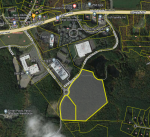 A representative of Dell EMC, and representatives of a real estate development team, urged including two Dell EMC parcels south of Crystal Pond Road. Chris Legocki, of Geystar told the board:
A representative of Dell EMC, and representatives of a real estate development team, urged including two Dell EMC parcels south of Crystal Pond Road. Chris Legocki, of Geystar told the board:
we think there’s a great opportunity here to effectively meet the housing goals that have been set forth by the state and expand and diversify Southborough’s housing stock while doing it in a way that mitigates public impacts to roads, infrastructure, utilities, and residential neighborhoods. and this being 35 ½ acres is obviously a substantial part of the land mass required outside of the half mile proximity to the to the train station
Luttrell explained that it was an area they initially targeted before getting “huge pushback” due to concerns that it would be rapidly developed, overburdening school and Town resources.
The area was still considered and weighed, despite not having been selected by the public during the mapping sessions.
One criteria that weighed against that parcel was being on the Open Space Commission’s list of priority parcels to pursue for open space protections. (Read more about that here.)
The representatives noted that the property is zoned as Industrial Park. If it isn’t used for MBTA zoning, something much less attractive could be built.
Member Jesse Stein pointed out to Legocki that developers can pursue a 40B project on the site. Legocki said that special permit comes with more public resistance and its better to align with zoning.
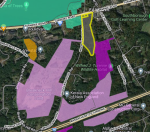 The open space issue was one of multiple criteria that impacted parcels at Turnpike and Woodland Road owned by Bob Heavey. The owner complained about not being included in the overlay.
The open space issue was one of multiple criteria that impacted parcels at Turnpike and Woodland Road owned by Bob Heavey. The owner complained about not being included in the overlay.
Heavey pitched that he had planned to only develop 5 acres for housing and donate the remainder of the 13 acres to the Town. That would allow the Town to link up adjacent conservation lands.
He was also told that properties were eliminated for having historic homes on them built prior to 1925. Heavey claimed that the properties are uninhabitable and he has been in the process of trying to get the last tenants out and have them torn down.
Resident Eric Glaser later called in to support including EMC, hoping it would help the Town meet affordable housing goals. (He noted that he opposes one of the 40B projects being pursued.)
Resident David Parry pushed back on Heavey’s land being eliminated due to a criteria about old homes that he said was “rubbish” since it could include buildings that are falling down. Member Marnie Hoolihan defended that those properties have an additional hurdle under the Demolition Delay Bylaw.
The board didn’t seem interested in revisiting the decisions on the EMC or Heavey parcels. They did promise to follow up to share the scoring details with the owners/developers.
Questions about Southside area historic homes & Cordaville Park/Triangle
Although the the board stated that parcels with properties older than 1925 had been eliminated from consideration, that wasn’t true for two. Parry and others pointed out that the overlay area #6 on the Southside includes two houses built before that date.
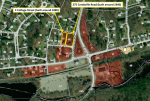 Johanna Cage highlighted that 3 Cottage Street and 275 Cordaville are “cornerstone houses of our community” and featured as historically significant on a sign in the Cordaville Triangle park. (Property records show they were built around 1880 and 1900.) She asked the board to reconsider the zoning for them.
Johanna Cage highlighted that 3 Cottage Street and 275 Cordaville are “cornerstone houses of our community” and featured as historically significant on a sign in the Cordaville Triangle park. (Property records show they were built around 1880 and 1900.) She asked the board to reconsider the zoning for them.
Luttrell responded that she would have to take another look. She had believed that pre-1925 buildings were removed from the list.
I looked back at Planning’s earlier sessions and it appears that other properties were flagged as historic and removed from the list but those two weren’t mentioned, their build dates weren’t listed, and members believed that all of the areas they designated met the board’s eligibility criteria (or were added for reasons explained below).
That section, which is the only one to meet the state’s requirement for 10 acres within a 1/2 mile of the train, already contains less than 10 acres of developable land.
In the board’s January 3rd Working Session, Town Planner Karina Quinn told members that their consultant, Bohler Engineering, told them that parcels they had selected didn’t have contiguous acreage needed.
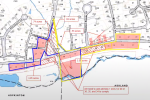 Quinn said that Bohler advised they were allowed to add in parcels to the overlay map that are excluded from MBTA zoning (redlined in the map right) to make it contiguous. The board agreed to add in Cordaville Park (a.k.a. the Triangle) and abutting wetland to its east.
Quinn said that Bohler advised they were allowed to add in parcels to the overlay map that are excluded from MBTA zoning (redlined in the map right) to make it contiguous. The board agreed to add in Cordaville Park (a.k.a. the Triangle) and abutting wetland to its east.
The Planner explained that, according to Bohler, parcels can count towards the minimum acreage even though nothing can be built on them. The Town just has to adjust the density for the land that can be built so that it averages 15 per acre across all the designated areas.
On Monday night, Quinn noted that Bohler had been tweaking the density for the overlay areas so that it will work in the state’s compliance model. (No information was shared yet as to what areas will have denser zoning and by how much.)
Still, some residents were concerned about the inclusion of Triangle Park in the zoned area.
Ann Deschamps, who abuts excluded-but-included land, expressed confusion about those areas being included in the map. She made clear that she distrusted promises that the parcels still couldn’t be developed if rezoned. John Cage (owner of 3 Cottage Lane) also worried about the park.
Planning members agreed to ask the Select Board if it will agree to transfer the Triangle Park to the Conservation Commission to be put under “Chapter 97” protection from development. Lutrell explained to the public that once under that designation, it would take an act of the state legislature to remove the protection.
Underlying Zoning
If you want to see details for the zoning laws that would still apply for the areas where MBTA zoning would be overlayed, use the links to the relevant sections of the Town code:
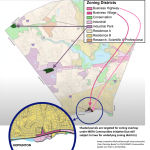 Area #6, the section on the southside, is currently zoned a combination of Business Village District and Business Highway District. (See image right.)
Area #6, the section on the southside, is currently zoned a combination of Business Village District and Business Highway District. (See image right.)- The other two sections, on Route 9 and the northwest corner of town, are zoned as in the Industrial Park District

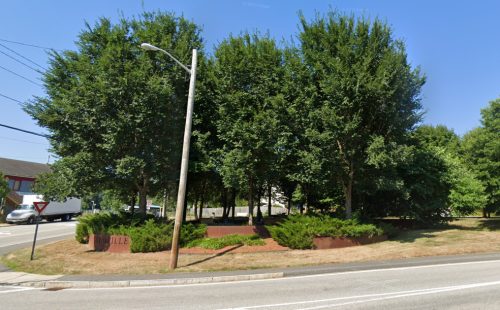

Just to remind people, here is the link to the 2019 open space plan which was referenced a few articles back on this topic — the list of properties identified as possibilities of open space is on page 170-171.
https://www.southboroughma.gov/DocumentCenter/View/2760/2019-Open-Space–Recreation-Plan?bidId=
HOUSING WITH NEW HIKING TRAILS – The writer of the first comment ( Eileen Samburg) refers to the important Town report, titled “Open Space and Recreation Plan Update 2019”. This report identifies land parcels with TOP PRIORITY for preservation of open space.
I own one of these “top priority” parcels. It was made top priority because it contains a large wetland area alongside Woodland Rd. near Rt 9.
This parcel is at 84 Turnpike Rd. and is about 13 acres. I also own two adjacent parcels. All three parcels together make a site with about 5 acres of DRY upland next to Rte. 9, suitable for rezoning to multi family housing under the MBTA Act.
What makes this site especially suitable is the OPPORTUNITY it presents for the Town to get ownership control over the high priority wetland along Woodland Rd.
If the Town owned this wetland, then the Town could create a “NEW WALKING TRAIL CONNECTOR”, passing across this wetland. This trail could connect together the two largest town owned parcels of open space, thereby creating a new and long “CIRCUIT TRAIL”. These two parcels are the former Davis Farm “Orchard” (Off Breakneck Hill Rd.), and the “Town Forest” ( Off Oak Hill Rd). The connecting trail could cross over Woodland Rd. and pass across the wetland.
If the dry upland portion of the sites next to Rt 9 is rezoned to multi-family, then I would consider DONATING the back wetland portion to the Town so that the Town could complete the walking trail and protect the important open space .
Thank you, Bob Heavey, bobsjag@aol.com.. I look forward to your comments and thoughts
I am surprised there have been no comments about the issue of “compliance” with the MBTA Communities Act, which is intended to produce multi-family housing SOON — in the NEAR FUTURE.
I wonder — Will Southborough be in compliance, if the sites chosen are NOT likely to be developed soon, in the near future, or ever ?
Please take a close look at the town map in the article above, which shows the three sites chosen. Very few of these sites are vacant. Instead, they contain valuable buildings, occupied by homes, apartments and active businesses. And most of these buildings are quite new.
So what is the probability of these sites being RE-developed as new multi-family housing … soon, in the NEAR FUTURE, or ever? The probability is obviously low. So, the question that may arise is this:
Could this selection of sites be construed as non-compliance with the INTENT of the State MBTA law ? Especially when there are many ALTERNATIVE sites which are not only vacant, but have also been proposed for multi-family housing, and in several cases their current owners want to build this housing … soon.
I support the Planning Board’s diligent efforts to come up with an acceptable proposal, when there are so many conflicting opinions making it impossible to satisfy everyone. But if a plan is approved, it had better comply fully with the intent of the State law.
In fact, the state has not purported that rezoning will create a sudden boon in housing. The zoning is intended to allow more incremental change by removing zoning barrier. The state had made clear in its promotions and in its posted regulations that it does not require zoning to be on parcels that are undeveloped or under developed. If the model is found to be somehow non-compliant, it shouldn’t be for that reason.
Not really on the main points of this item, but isn’t the Cordaville Triangle beautiful? Some people caught a lot of flak in its creation, but they were visionaries.